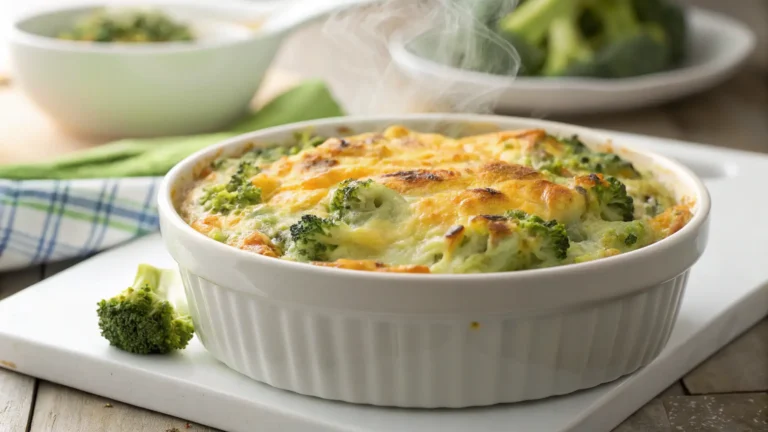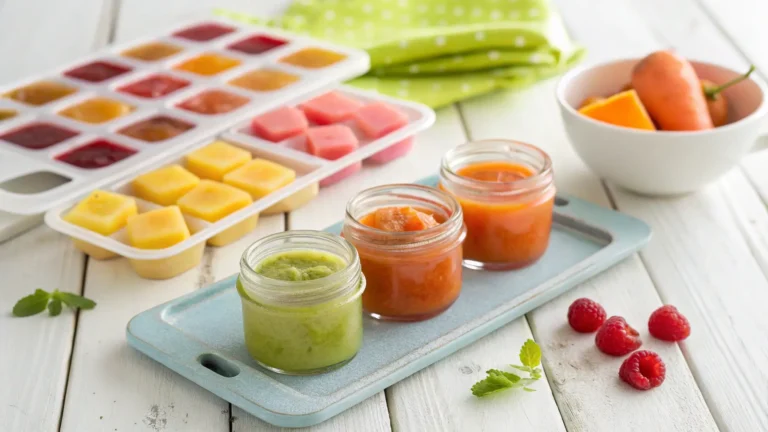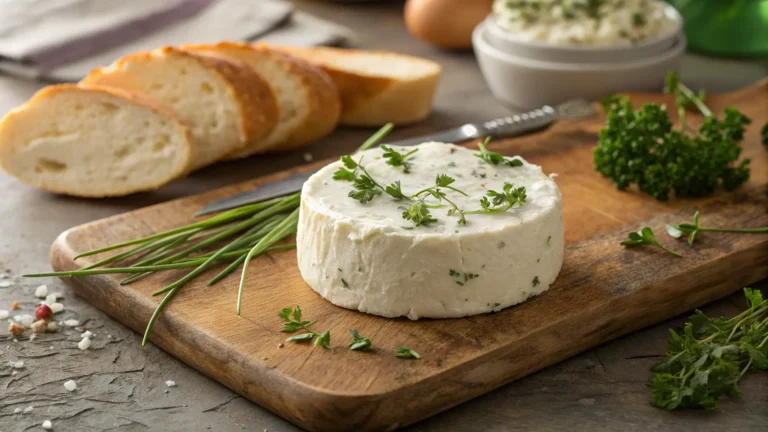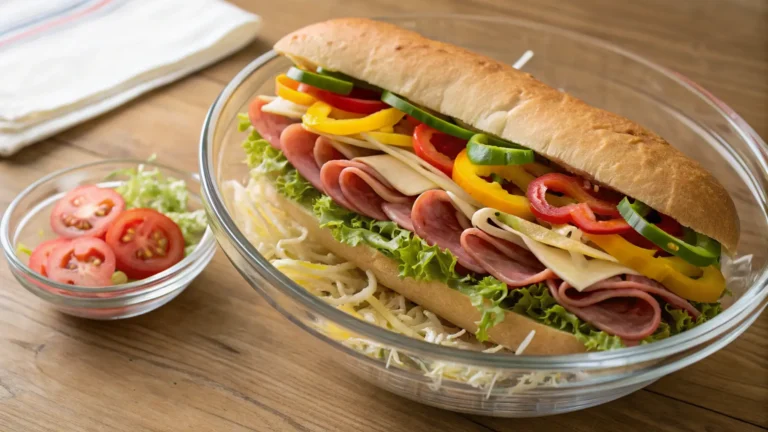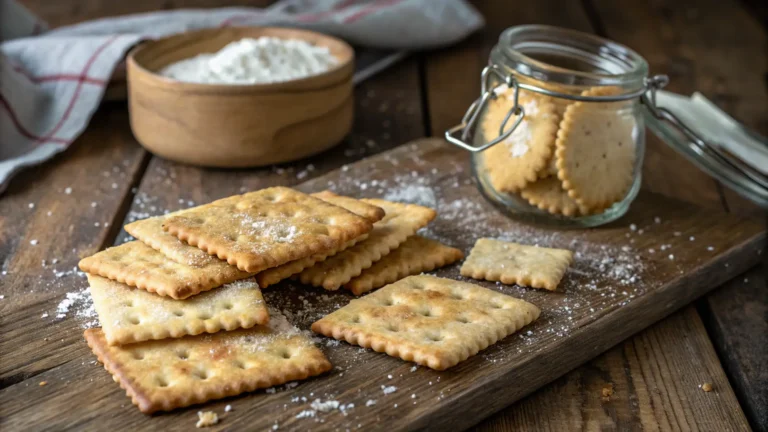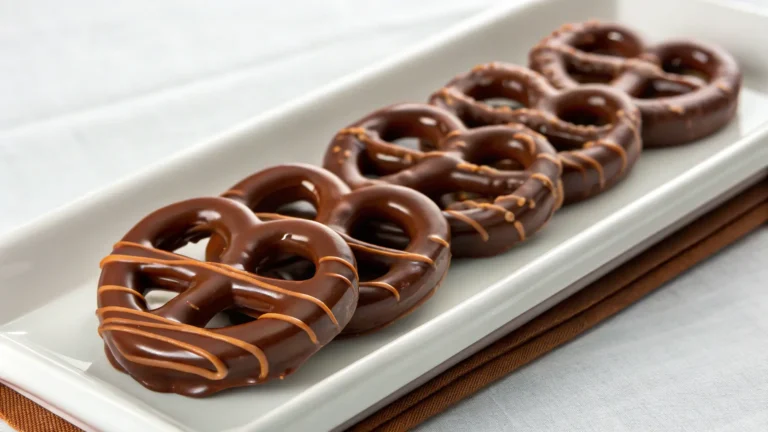Crab Brulee Recipe: A Bold Twist on a Classic Dessert
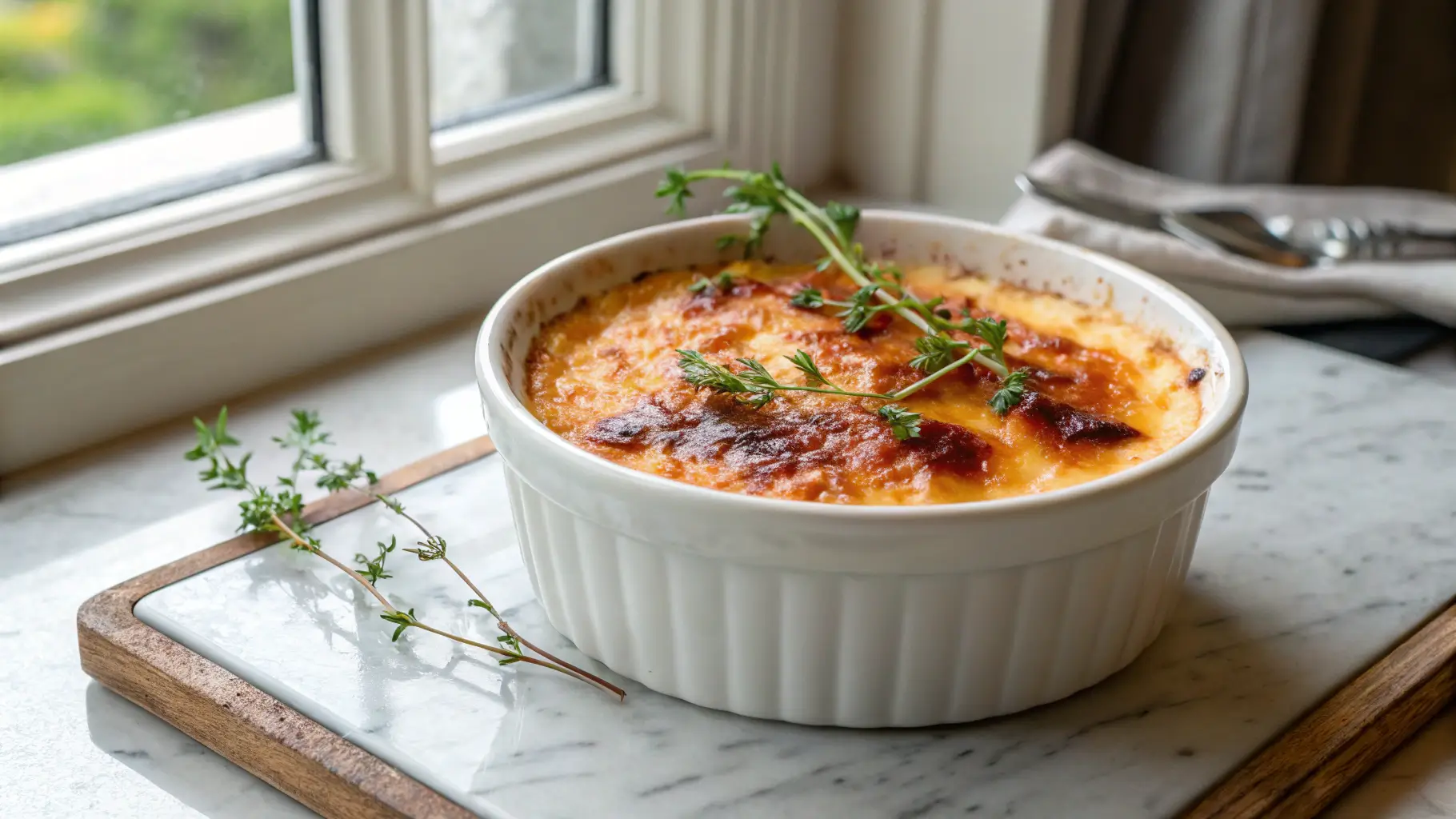
Table of Contents
When you think of crème brûlée, your mind likely jumps to creamy vanilla custard crowned with a crisp sugar crust. But what if we flipped the script and made it savory? That’s exactly what the crab brulee recipe does. This unexpected twist combines the velvety richness of custard with the delicate sweetness of crab, topped with a brûléed finish that adds just the right amount of crunch. In this guide, we’ll walk you through everything from selecting the best ingredients to mastering the torch technique.
This crab brulee recipe is a favorite among adventurous foodies and seafood lovers looking for a gourmet appetizer that surprises and satisfies. Whether you’re hosting a dinner party or trying to impress someone special, crab brûlée might just become your new go-to.
Looking for inspiration? Try this Smoked Fish Brine Recipe for another seafood twist.
Let’s dive into this creamy, savory masterpiece and discover how a simple crab brulee recipe can elevate your cooking game.
What is Crab Brûlée and Why It’s Gaining Popularity
The Unexpected Charm of Savory Crème Brûlée
Traditional crème brûlée is a dessert known for its creamy vanilla custard base and caramelized sugar top. The crab brulee recipe, however, flips that expectation by replacing sweet elements with savory ones. This version swaps sugar for a sprinkle of Parmesan or savory crumbs, and instead of vanilla, you’ll infuse your custard with fresh herbs, spices, and most importantly—succulent crab meat.
Crab brûlée isn’t just an attention grabber on upscale menus; it’s a fusion of high-end cuisine with comfort food. It’s rich, creamy, and full of umami, offering something completely new in the world of appetizers.
How Seafood Meets Dessert in Culinary Innovation
Culinary creatives have long been experimenting with breaking the sweet-savory boundary, and crab brûlée recipes are some of the most successful examples of this trend. This dish fuses French technique with coastal ingredients, embracing both elegance and warmth.
Savory custards have roots in European cooking, especially in quiches and pâtés. But by topping it with a brûléed finish, chefs bring in an element of drama—cracking the crust never gets old. From Michelin-starred restaurants to coastal bistros, this innovative dish is winning fans.
Crab adds a luxurious texture and natural sweetness that complements the creamy custard. It’s a balance of bold and subtle, rich and light—making this dish perfect for foodies who want more than the ordinary. Learn more about our bold takes on proteins in this Venison Steak Recipe Guide.
Ingredients Needed for the Perfect Crab Brûlée Recipe
Choosing the Best Crab Meat for Maximum Flavor
When it comes to making an unforgettable crab brulee recipe, quality crab meat is non-negotiable. You’ll want sweet, delicate crab that blends beautifully into the creamy custard base. The best choices? Lump crab meat or backfin crab, preferably wild-caught and freshly picked. These varieties offer the ideal texture—tender and flaky without being too watery.
Avoid imitation crab or overly processed varieties, as they can overpower the balance of flavors or release too much liquid during baking. Freshly steamed crab meat is ideal, but high-quality canned or refrigerated options can also work in a pinch—just make sure you thoroughly drain and pick out any shells.
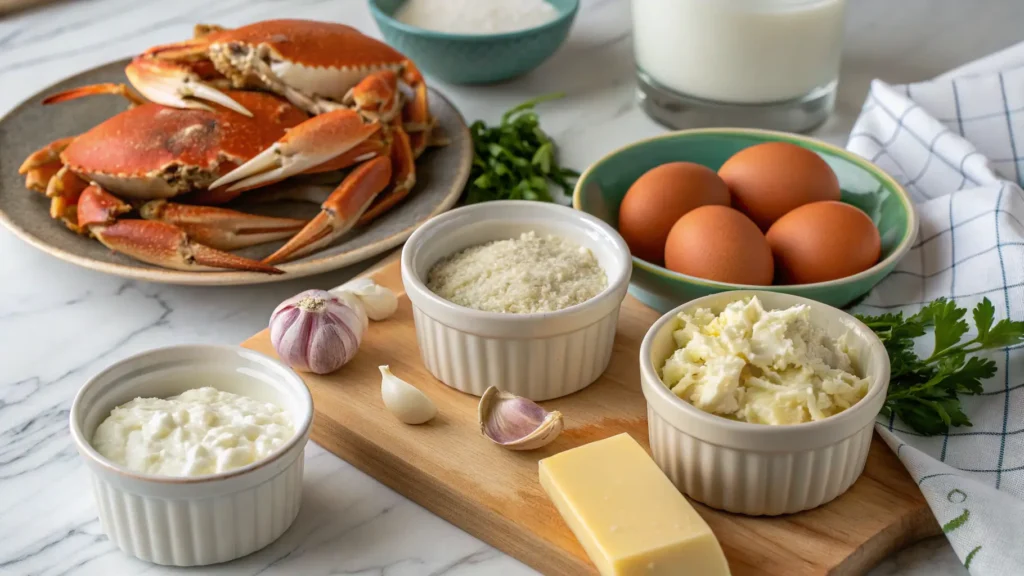
Pro tip: If you’re sourcing crab locally, blue crab and Dungeness are exceptional picks for a richer, sweeter profile.
Looking for inspiration? Try combining your crab with our Wagyu Ground Beef Recipe for a surf-and-turf twist in other gourmet meals.
Essential Ingredients and Their Purposes
Creating the perfect crab brulee recipe requires a balance between savory depth and custard-like silkiness. Here’s what you’ll need for 4 servings:
| Ingredient | Quantity | Purpose |
|---|---|---|
| Lump crab meat | 1 cup | Provides texture, protein, and sweet seafood flavor |
| Heavy cream | 1 cup | Base for rich, creamy custard |
| Egg yolks | 3 | Thickens the custard and adds richness |
| Parmesan cheese (grated) | ¼ cup | Savory topping, replaces sugar brûlée crust |
| Shallots (finely chopped) | 1 tbsp | Adds depth and slight bite |
| Garlic (minced) | 1 clove | Enhances umami and fragrance |
| Dijon mustard (optional) | 1 tsp | Adds complexity and contrast |
| Salt and black pepper | To taste | Seasoning balance |
| Fresh herbs (chive, dill) | 1 tbsp | Brightens and lifts the dish |
You may also consider a dash of Old Bay seasoning or smoked paprika if you enjoy a touch of Southern or coastal flair in your seafood.
When preparing your custard, whisk the egg yolks and heavy cream gently to avoid incorporating too much air, which can result in a foamy or cracked texture. Fold in the crab meat last to preserve its structure and keep the bites juicy.
Heavy cream is key here—it creates the signature silky custard base. Wondering if heavy whipping cream is the same? We’ll explore that nuance in the FAQ section.
Don’t miss our Disclaimer page to learn more about recipe testing and sourcing practices.
Equipment You Need to Make Crab Brûlée at Home
Kitchen Tools for Preparation and Presentation
Making a restaurant-worthy crab brulee recipe at home doesn’t require a chef’s arsenal, but there are a few essential tools that make a major difference in both texture and appearance. Here’s what you’ll want to have on hand:
| Tool | Purpose |
|---|---|
| Mixing bowls | To blend the custard and crab mixture evenly |
| Fine mesh strainer | For achieving a smooth custard by removing egg solids before baking |
| Whisk | Gently incorporates the egg yolks and cream without adding air |
| Measuring cups/spoons | Accuracy is everything for custard chemistry |
| Ladle | Helps transfer the custard into ramekins without mess |
| Baking dish (deep) | For water bath (bain-marie) that prevents overcooking |
| Aluminum foil | Covers the ramekins to ensure even steaming |
For serving, use white ceramic ramekins—they not only conduct heat well but also highlight the rich color of the crab custard. Choose ramekins with a 4-ounce capacity for individual servings.
Not sure where to begin with your cookware game? Discover great ideas like how to slow cook meats in our Slow Cooker Cube Steak Recipe for more pro tips on presentation.
Best Ramekins and Torches for That Signature Crust
Let’s be honest—the brûléed top is the showstopper. And for that, you’ll need the right tools. A culinary torch is the gold standard for caramelizing the topping without cooking the custard beneath it.
Recommended culinary torches:
- Iwatani PRO2: Precision and power with adjustable flame control
- Jo Chef Kitchen Torch: User-friendly and great for beginners
Don’t have a torch? You can broil the ramekins under your oven’s broiler, but the results may be uneven or overcooked. A good kitchen torch is worth the investment—especially for dishes like this.
And those ramekins? Look for ones with straight sides and shallow depth to get that perfect custard-to-topping ratio. Porcelain ramekins with fluted edges not only look professional but retain heat evenly, ensuring consistent texture.
Bonus Tip: Always torch just before serving to preserve the crispy topping. If prepped in advance, refrigerate the un-torched custard and brûlée only when guests are ready.
Don’t miss our Terms of Use page for details on recipe usage and creative rights.
Step-by-Step Guide to Making Crab Brûlée
Preparing the Crab Custard Base Properly
Now that you’ve gathered everything, it’s time to bring your crab brulee recipe to life. What makes this recipe stand out is the balance between the custard’s creaminess and the sweet brininess of the crab. When preparing this savory custard, your goal is to preserve the delicate texture of the seafood while locking in rich flavor.
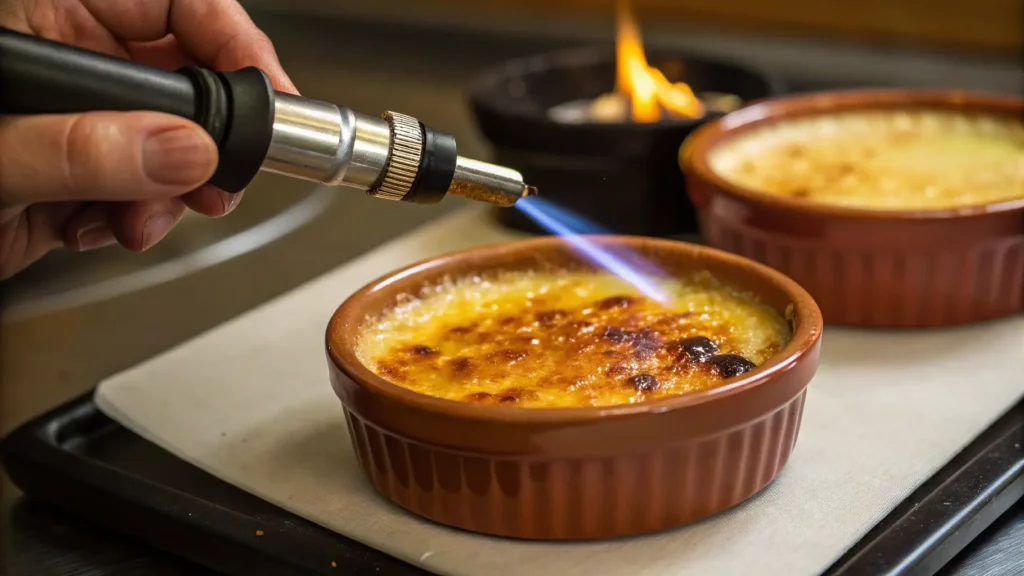
Here’s how to get started with your crab brulee recipe:
- Preheat the oven to 300°F (150°C). Low heat ensures your custard cooks gently, resulting in a silky texture.
- In a saucepan, heat the heavy cream with garlic and shallots over medium-low. Simmer just until aromatic—don’t let it boil.
- In a separate bowl, whisk the egg yolks, Dijon mustard, salt, and pepper until smooth.
- Temper the yolks: Slowly add the hot cream to the egg mixture, whisking constantly to prevent curdling.
- Strain the custard base through a sieve for a lump-free finish.
- Gently fold in the crab meat to keep its chunks intact.
This is the heart of your crab brulee recipe—a luxurious custard infused with the ocean’s sweetness. Make sure you’re using lump crab meat for the best result.
Once blended, ladle the mixture into ramekins, about ¾ full each.
Baking and Torching for That Golden-Brown Top
To complete this elegant crab brulee recipe, you’ll need a perfect bake and that signature brûléed finish. Use a bain-marie to prevent the custard from cracking or becoming rubbery.
- Place ramekins in a deep baking dish. Add hot water until it reaches halfway up the ramekins.
- Loosely cover with foil.
- Bake for 30–35 minutes, until the edges are firm but the center still jiggles slightly.
- Let them cool, then chill in the refrigerator for 2 hours minimum.
When ready to serve, top each with either:
- Grated Parmesan cheese
- Lightly buttered panko
- Optional: a dash of smoked paprika
Using a kitchen torch, caramelize the topping until it bubbles and browns. This is where your crab brulee recipe truly becomes restaurant-worthy. The crisp top contrasts beautifully with the soft, savory custard below.
Prefer a hint of sweet with savory? Add a sprinkle of Demerara sugar before torching. The lightly sweet brûlée top with the umami crab base is next-level culinary magic.
And for garnish? Try lemon zest, microgreens, or chive oil for an elegant finish to your crab brulee recipe.
For more seafood custard techniques, check out our flavorful Smoked Fish Brine Recipe—perfect for learning how salt and seasoning enhance seafood textures.
Tips, Tricks, and What Not to Do
Common Mistakes and How to Avoid Them
Even though the crab brulee recipe seems straightforward, small missteps can lead to runny custard, overcooked eggs, or a mushy texture. Below are common pitfalls to watch for and how to steer clear of them:
1. Overcooking the custard
This is the number one way to ruin your savory brûlée. Custards are delicate—bake too long and they turn rubbery or grainy. Always look for that slight jiggle in the center and remove from heat promptly.
2. Boiling the cream
In a proper crab brulee recipe, the cream should only be gently heated. If it boils, it can scramble the egg yolks during tempering or cause separation when baked.
3. Using low-fat dairy
Heavy cream is essential. Using milk or half-and-half will not yield the rich, silky texture this dish is known for. If you’re wondering whether heavy cream and whipping cream are the same, the FAQ section covers that in depth.
4. Skipping the straining step
This might seem optional, but it’s crucial for a smooth finish. Straining removes any bits of cooked egg or shell, giving your crab brulee recipe a luxurious feel.
5. Overmixing the crab meat
You want to keep the crab in soft chunks—not mashed. Fold gently into the custard just before portioning.
6. Brûléeing too early
Always torch just before serving. Doing it in advance makes the topping soggy. A true crab brulee recipe deserves a crunchy, caramelized top that contrasts perfectly with the creamy center.
Looking for inspiration? Try these creative techniques in our Wagyu Ground Beef Recipe where timing and prep are just as critical.
Tips for Perfect Texture and Flavor Every Time
To master your crab brulee recipe, focus on these final details:
Use room temperature eggs:
They mix better and reduce the risk of scrambling when tempered.
Season carefully:
Crab is naturally sweet and salty. Taste the custard base before baking to avoid over-seasoning.
Add flavor layers:
Consider infusing your cream with thyme, tarragon, or a bay leaf before mixing. A hint of mustard or Worcestershire sauce can deepen the umami.
Rest before chilling:
Letting the custards cool slightly before placing in the fridge prevents condensation that can water down your crust.
Finish strong:
Top with fresh herbs or a small crab claw for presentation. Don’t underestimate the visual appeal of a well-plated crab brulee recipe.
Crab Brulee Variations You’ll Love
Adding Spice or Herbs for Extra Depth
The classic crab brulee recipe is stunning on its own, but the beauty of this dish lies in its flexibility. You can tweak flavors, heat levels, and aromatic profiles to suit your guests—or your own adventurous cravings.
Here are some variations that bring new life to the traditional crab brûlée:
1. Spicy Cajun Crab Brulee
Add a pinch of cayenne, paprika, or your favorite Cajun seasoning to the custard base. The warmth pairs beautifully with the natural sweetness of the crab. For added texture, top with buttery crushed crackers before torching.
2. Herb-Infused Cream
Simmer your cream with sprigs of thyme, tarragon, or even bay leaf before mixing it into the custard. These earthy notes balance the richness and elevate your crab brulee recipe with minimal effort.
3. Truffle Crab Brulee
Want to take things ultra-gourmet? A touch of white truffle oil in the custard or shaved truffles as garnish transforms your dish into fine dining. Just go easy—it’s powerful stuff.
4. Lemon Zest + Dill
Bright and aromatic, this combo gives your brûlée a fresh edge. Add lemon zest into the custard and top with fresh dill right before serving. It’s perfect for spring or summer menus.
These tweaks don’t just adjust the taste—they also affect the overall tone of the dish. A bold variation makes your crab brulee recipe a star at cocktail parties, while an herbaceous version feels right at home during a quiet dinner for two.
Don’t miss our Smoked Fish Brine Recipe for more savory seafood dishes you can tweak with herbs and spices.
Other Seafood or Vegetarian Alternatives
Not a crab fan? Or maybe you’re catering to a pescatarian or vegetarian guest list? The custard method in your crab brulee recipe works beautifully with several substitutions.
Alternative Seafood Ideas:
- Lobster: Richer and slightly firmer than crab—use tail meat and chop finely.
- Scallops: Dice small for an elegant, mild option.
- Smoked Salmon: Adds a smoky, briny note; skip the Parmesan topping and try everything bagel seasoning instead.
Vegetarian Options:
- Caramelized Onion and Goat Cheese Brulee: Replace crab with slow-cooked onions and a touch of chèvre. Top with breadcrumbs or grated Gruyère.
- Roasted Mushroom Brulee: Umami-rich and satisfying—this pairs perfectly with rosemary cream.
Just remember to keep the ratio of custard to fillings balanced. You want enough mix-ins to offer bites of flavor without overwhelming the structure.
Pairing Ideas and Serving Suggestions
What Wines and Sides Work Best with Crab Brûlée
When it comes to serving your crab brulee recipe, pairing it thoughtfully can elevate the dish from delightful to unforgettable. Because it’s rich, savory, and creamy, the key is to balance those qualities with bright, acidic, or crisp flavors and textures.
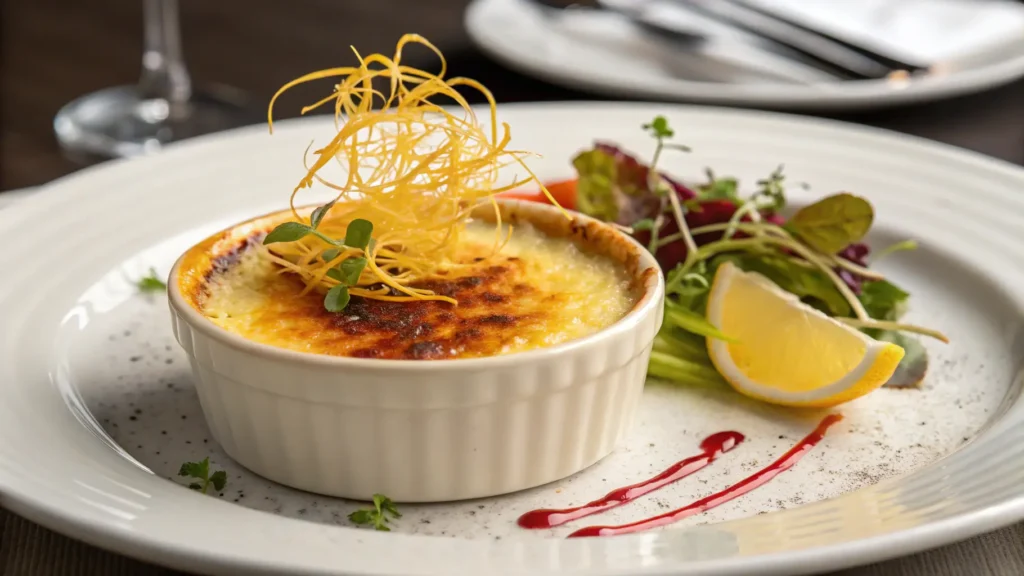
Best Wine Pairings:
| Wine | Why It Works |
|---|---|
| Chardonnay (unoaked) | Its bright acidity cuts through the richness of the custard |
| Champagne or Brut Sparkling | Adds contrast with bubbles and minerality |
| Sauvignon Blanc | Citrus notes pair well with crab, especially lemon-herb versions |
| Viognier | Slightly floral and peachy, great with crab and truffle combos |
Avoid heavy, oaky wines, which can compete with the creamy texture of your crab brulee recipe.
Top Non-Alcoholic Options:
- Sparkling water with a lemon twist
- Chilled cucumber mint mocktails
- Cold brewed white tea with a splash of citrus
Looking for something heartier? Serve the brûlée with a petite arugula salad drizzled in a lemon vinaigrette. The peppery greens and acidity add the freshness needed to balance the dish.
Plating and Garnishing Tips for a Restaurant-Style Look
Presentation plays a huge role in the dining experience—especially for a dish as unique as a crab brulee recipe. Here’s how to impress:
1. Use Uniform Ramekins
Choose matching ramekins in white or light gray to highlight the golden brûlée top. Smaller 4-ounce ramekins are perfect for individual servings.
2. Add Visual Garnish
- A sprig of fresh dill or thyme on top
- A curl of lemon zest
- Microgreens or edible flowers for color contrast
3. Serve on a Small Plate with Accents
Set the ramekin on a small saucer and add a spoon with a garnish leaf or lemon slice. You can also serve it with a small piece of crusty toast or flatbread for texture contrast.
4. Keep it Chilled Until Torch Time
For best results, torch the top just before bringing it to the table to retain that dramatic, crunchy crust. This is especially important when showcasing your crab brulee recipe at dinner parties or events.
Want more tips on elevating your main dishes with bold presentation? Don’t miss our flavorful approach to proteins in the Venison Steak Recipe Guide.
Comparing Crab Brulee to Traditional Crème Brûlée
Flavor and Texture Contrasts Between Sweet and Savory
When comparing a crab brulee recipe to the classic crème brûlée dessert, it’s not just a shift in ingredients—it’s a complete transformation in experience. While they share technique, the result on the palate is entirely different.
| Element | Classic Crème Brûlée | Crab Brulee Recipe |
|---|---|---|
| Base Flavor | Sweet vanilla custard | Savory seafood custard with herbs and seasoning |
| Texture | Silky, dessert-like, sugary crust | Creamy, umami-rich, with a crispy savory topping |
| Topping | Caramelized white or brown sugar | Torched Parmesan, breadcrumbs, or savory sugar alternatives |
| Aromatics | Often includes vanilla bean or orange zest | Includes garlic, shallot, herbs, mustard, or truffle oil |
| Occasion | Served as dessert | Served as an appetizer or small plate |
A crab brulee recipe has more complexity from a flavor standpoint. The sweetness of crab offsets the creaminess of the custard, while aromatic herbs and spices offer depth. The savory brûlée top delivers crunch, salt, and even a bit of spice if you use seasoned breadcrumbs or cheese.
Sweet brûlée is all about contrast between silky custard and burnt sugar. But in savory versions, you’re playing with contrasts of umami, fat, and acid. And because of this balance, a crab brulee recipe can hold its own as a showstopper starter in a multi-course meal.
Health and Nutritional Comparison
Health-wise, both the classic and savory versions are indulgent. However, the crab brulee recipe has some nutritional upsides thanks to its seafood base.
Here’s how the two stack up:
| Nutrition Aspect | Crème Brûlée (per serving) | Crab Brulee Recipe (per serving) |
|---|---|---|
| Calories | 300–400 | 250–350 |
| Protein | ~5g | ~14g (from crab meat and egg yolk) |
| Fat | High (from cream + sugar) | Moderate (cream, crab, cheese) |
| Sugar | 20–30g | <3g (only in topping if sugar is used) |
| Carbs | ~25g | ~4–8g (mostly from topping if any) |
So if you’re watching sugar intake or looking for a high-protein appetizer, the crab brulee recipe offers a savory alternative that doesn’t compromise on richness or satisfaction.
It’s not often you find a dish that delivers gourmet appeal and better macros at the same time.
Looking for another unique seafood-based starter? Discover the bold layers of our Wagyu Ground Beef Recipe for more protein-forward creativity.
Conclusion: Why the Crab Brulee Recipe Deserves a Spot on Your Table
The crab brulee recipe may sound like a culinary curveball, but it delivers rich flavor, elegant presentation, and restaurant-level appeal right at home. It’s a brilliant mashup of French technique and coastal ingredients—a creamy, savory custard topped with a torch-blistered crust that’ll steal the spotlight at any gathering.
Whether you stick to the classic or experiment with herbs, spice, or seafood variations, this is one dish where technique meets bold creativity. Plus, it’s surprisingly approachable with the right ingredients and tools.
Looking for inspiration? Try our Venison Steak Recipes or learn more about seafood prep from the Smoked Fish Brine Recipe. And if you’re craving a meatier twist, don’t miss the Wagyu Ground Beef Recipe—a masterclass in rich, protein-packed cooking.
FAQs – Everything You Need to Know About Crab Brûlée
Below are the most commonly asked questions around the classic custard—and how they relate to your savory twist on the crab brulee recipe.
What is the secret to crème brûlée?
The secret lies in low, gentle baking and using high-fat cream. For savory versions like the crab brulee recipe, this also includes gently folding in ingredients like crab without overmixing, and torching the topping just before serving to keep that signature crunch.
What’s the difference between custard and crème brûlée?
All crème brûlée is custard, but not all custard is crème brûlée. Crème brûlée specifically includes a caramelized sugar top (or savory brûléed topping in a crab brulee recipe) and is served chilled in ramekins. Custard can refer to any thickened egg-milk mixture and is often served warm.
What type of cream is best for crème brûlée?
Heavy cream is the best choice due to its high-fat content. In your crab brulee recipe, this ensures the custard sets properly while still delivering that luxurious, silky mouthfeel. Lighter creams may curdle or result in a loose texture.
What are the main ingredients in crème brûlée?
Traditionally, crème brûlée is made from egg yolks, heavy cream, vanilla, and sugar. In a crab brulee recipe, sugar and vanilla are replaced with savory aromatics like garlic, shallots, herbs, and of course, fresh lump crab meat.
Do you put heavy cream or whipping cream in crème brûlée?
You should use heavy cream, not regular whipping cream. While both have similar fat content, heavy cream creates a more stable, rich custard. The same rule applies in a savory crab brulee recipe—the cream makes or breaks the texture.
Is heavy cream the same as heavy whipping cream?
Yes, they’re mostly the same and can be used interchangeably in recipes like crab brulee. Just make sure you’re not using light whipping cream or half-and-half, which won’t provide the structure you need.
What not to do when making crème brûlée?
Here’s what to avoid, whether sweet or savory:
Boiling the cream
Skipping the straining step
Overbaking the custard
Brûléeing too early
All of these will ruin the delicate texture and flavor balance of your crab brulee recipe.
Can I use milk instead of heavy cream for crème brûlée?
Technically yes, but you’ll get a less rich result, and the custard may not set properly. For a true crab brulee recipe, heavy cream is a must to support the savory flavors and texture.
How to mess up crème brûlée?
The most common ways:
Overcooking the custard
Using low-fat dairy
Failing to temper the eggs
Skipping the water bath
Each mistake is magnified in a crab brulee recipe due to the delicacy of crab meat and custard.
What is the best sugar for crème brûlée topping?
For sweet versions, turbinado or Demerara sugar caramelizes best. But in a crab brulee recipe, sugar may be swapped for Parmesan, breadcrumbs, or even a light touch of raw sugar mixed with savory herbs for a sweet-salty topping.
Have you given our recipe a try?
There are no reviews yet. Be the first one to write one.

